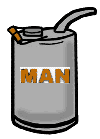|
Past Preventive Maintenance columns: A
Closer Look at Spindles and Turrets The
Next Level: Accuracy—Checking Backlash on Lathes
Inspecting
the Electrical Cabinet Everyone's
Favorite Task—Cleaning Coolant—The
Most Ignored Fluid in your Machines It's
Summertime—Is your Chiller Working? The
Other Oils—Inspecting the Main Hydraulic Systems
|
MIKE BREEN ON PREVENTIVE MAINTENANCE |
|
Completing Lathe by Michael W. Breen |
|
|
Now, we will wrap up PM for the lathe by addressing tailstock, sub-spindle, and zero-point alignments. Zero Points – Z-Axis Whether you have a conventional two-axis system or an extra axis for off-center milling and drilling, the reference point for this check is the main spindle. When the Z-axis is set, ask the programmer about the location of the programmed zero position. This will normally require a touch of the turret face to the reference point. Use the hand wheel and a piece of paper as a buffer. Jog the axis to the reference position; then, enter it into the machine parameters. Refer to your machine manuals to find the correct method for entering this position. Zero Points - X Axis Even if your turret and headstock are aligned, tool wear and scrap will still be a problem if your zero point is off. When drills and mills cut off-center, their accuracy of diameter throughout the cut will deviate. Set the X-axis zero point when aligning the turret. Mount a coaxial indicator in the chuck and sweep the turret drill holder. When the indicator repeats in reference to the X-axis, that is the zero point. Your extra axis also will reference the center of the cutting face. Again, check your machine tool manual because entering the wrong information could be catastrophic. Tailstock In my opinion, the best way to check tailstock alignment is during a cut, because indicators cannot simulate machining and things flex a little when tool pressure is applied. Mount a piece of material between the aligned headstock and the tailstock. (The material should be close to the average size of the production parts and at least 2" in diameter and 12" in length.) Perform a cut until all areas of the test piece are cleaned up, make a finish pass, and then check both ends with a micrometer. Do not remove the piece from the machine at any time, because it will be used as a reference during the alignment procedure. If the diameter at the chuck side is larger, the tailstock is pointing towards the turret (upper turret on four-axis lathes). If the diameter is larger on the tailstock side, the tailstock is pointing away from the turret. To correct this, mount an indicator near the end of the part on the tailstock side. (The tip of the indicator should be mounted where the cutting tip makes contact with the part.) Move the tailstock to remove the run-out. Whatever the value of the run-out in the diameter is, move the tailstock by half of that value. Be sure to reference the indicator movement, not the control display. Lock the tailstock down and perform another cut. Repeat until the run-out falls within machine specifications. Sub-Spindle The sub-spindle is treated a bit like the tailstock, but it also must be aligned like the main spindle. The two usually hand off parts to one another, so they must be aligned accordingly. In addition, the sub-spindle must be able to perform like the main spindle: that is, cutting with no run-out. After aligning the sub-spindle (no run-out on cut), mount a coaxial indicator to the main chuck and move the sub-spindle to the main, and check the test piece rotationally. If there is run-out, the sub-spindle will have to be moved uniformly. Use an indicator mounted to the turret with the indicator tip mounted at the cutting point on the part. Moving the Z-axis and the tailstock at the same time will ensure that the move is uniform. These PMs can be confusing if you have not performed them before. I suggest that you bring your machine tool representative in the first time that you conduct the checks discussed here. Make sure the person who is going to be performing these tasks is there working with the engineer without any interruptions. Next, we’ll start getting into machining centers and mills. Talk to you next month. Mike Breen began as an aircraft electrician in the U.S. Army’s 101st Airborne. As a Certified Electronic Engineer with 14 years’ experience in machine tool repair, he is presently a Field Service Engineer with Ellison Machinery Company of Wisconsin. Mike has held this position for more than six years, during which he has designed and implemented complete preventive maintenance programs for many successful companies resulting in significant increases in their machines’ performance. For comments and inquiries about these articles, his e-mail address is mbreen@ellisonwi.com. - January 2001 |

 We covered a lot of ground last month when we discussed checking the headstock and turrets.
We covered a lot of ground last month when we discussed checking the headstock and turrets.